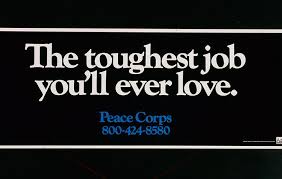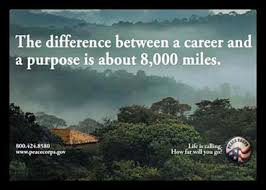Restructuring The Peace Corps
Emphasize the Peace Corps’s Third Goal
Most people are aware of the Peace Corps’s first two goals—contribute to the developing of critical countries and regions, and promote international cooperation and goodwill—but few have ever heard of the Third Goal, which many RPCVs view as the most important. The Third Goal states that RPCVs should help to educate Americans about the world beyond its borders, enabling citizens to participate in foreign affairs with greater sophistication and sensitivity. The agency could continue the service of Returned Peace Corps Volunteers by establishing opportunities for RPCVs to tell their stories through public schools and a variety of national organizations, including the Library Association, Rotary, Kiwanis, Lions, League of Women Voters, National Council of La Raza, National Association for the Advancement of Colored People and the National Organization for Women.
While today there is a Third Goal Office in the agency it should be expanded to train, support and finance travel and other expenses for RPCVs to educate and inform Americans about the developing world.
Health Care for RPCVs
Equally important is changing the health benefits for Returned Peace Corps Volunteers. Congressional action must close the gaps that currently exists in medical care for RPCVs, in part to ensure that they receive affordable treatment for diseases and ailments resulting from their overseas tours. For too long, too many RPCVs have lived and suffered with ailments caused by their service to America, and the U.S. Congress, regardless of the Administration, has done nothing to help these Peace Corps Volunteers.
End The Two-Year Commitment
It was Kennedy who asked, when first proposing a “peace corps’’ at 2:00 A.M. on October 14, 1960, on the steps of the Student Union of the University of Michigan, “How many of you are willing to spend ten years in Africa or Latin America or Asia working for the U.S. and working for freedom?”
Today, as it has been since 1961, the Peace Corps commitment has only been for two years of service. The problem is that two years isn’t long enough. Most Volunteers encounter a steep learning curve during the first nine to twelve months in-country. It takes time to master a foreign language, understand the nuances of the local challenges, and become comfortable with the job and the new environment of the host country.
Peace Corps Volunteers should be able to combine their first two years of service with an additional one to three years as career employees of the US government within their country of service.
Completion of such a five-year commitment would ensure the PCV employment back home for an additional two years, if not within the agency itself, then elsewhere in the government—the State Department, for example, or USAID.
Let the Peace Corps Shine on Social Media
One of the great ironies of Peace Corps history is that, while the general public has embraced the organization, Americans never seem interested in learning much about it. In the first days of the agency, Peace Corps was seen as a romantic venture. Its existence suggested that idealistic American youth, motivated by visions of self sacrifice and perspective-broadening travel, were doing everything they could to fix the world’s stubbornness problems.
In those days Volunteers were recognized for what they were doing overseas. Newspapers and magazines—from the Oakland, California Tribune to the Trenton, New Jersey Times—celebrated the agency’s first anniversary. In a March 1962 editorial, the New York Herald Tribune declared, “The Peace Corps is proving itself an impressive, and inspiring example of American idealism in action.” Also that year, a Time magazine cover story described the Peace Corps as “the greatest single success of the Kennedy administration.” In 1965, Sargent Shriver was on Time’s cover as the founder and first director of the Peace Corps; the headline of the cover story was “A U.S. Ideal Abroad.”
Those Were The Days.
The Peace Corps and its work have receded from the nation’s consciousness. It is only in the wake of tragedy that mainstream media choose to spotlight the dangers faced by many Peace Corps Volunteers.
Armed with today’s technology, talented Volunteers can take control of their own story and promote the work of the agency on social media. Some Volunteers are already showing the Peace Corps’s face to the world. In 2012, RPCV Chris Hedrick, then Country Director in Senegal, revamped that country’s Peace Corps website and encouraged Volunteers to tell their stories while in service. South African PCV Alan Toth created a website of videos in 2015 called “Posh Corps”; the site’s mission was “to discuss the modern Peace Corps experience honestly… cut through the mythology and the marketing, and capture the experience of volunteering in a rapidly changing world.”
Allan Mondell, a former Volunteer in Sierra Leone and a documentary filmmaker for 45 years, produced Waging Peace: The Peace Corps Experience, a 2012 film that told the stories of four returned Volunteers whose experiences shaped the rest of their lives.
Today, Alana DeJoseph, a film producer who served as a PCV in West Africa, is completing a documentary history of the agency called A Towering Task, which was the title of the original working paper for the creation of the Peace Corps.
As we compete in an ideological war with ISIS, stories of the Peace Corps are a wasted asset. More must be done by the government to tell the Peace Corps story both at home and abroad. A film on the history and the future of the Peace Corps needs to be produced by USIA, a film that captures the genius of the agency and the significant role it plays in global understanding.






Totally agree with you, John…PC’s Third Goal is even more important than first 2, in my view. After all, most PCV’s get at least as much out of PC service as they give…What PCorps is missing is news on what is being done by RPCVs on our return….e.g., I contributed to and continued to work on restoring Vermont’s longest running water powered sawmill, so that Calais, Vermont would have centerpiece for their historical museum. Also did community development work (learned from my village sojourn) in revitalizing an Oldtown, participated in Liveable Cities seminars to teach community development concepts, etc….I know many others from our Turkey V group that have contributed, but does PCorps have a mechanism for spreading the word? Not that I know of! Harlan Green, Turkey V.